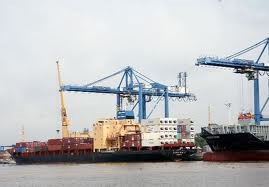Anxious looks at trade deficit
 |
| illustration photo |
According to latest General Statistics Office (GSO) figures, processed items using a large proportion of imported materials held the majority among items with buoyant export figures in the first quarter of 2011.
For example, the export value of textiles and garments hit $2.79 billion, hiking 27.9 per cent against corresponding period in 2010. However, the sector’s imported production materials surged from 22.1 per cent to 126.7 per cent in value in the same period. Cotton import values reached $336 million, up 126.7 per cent, yarn $404 million, up 70.9 per cent and fabric $1.41 billion, up 40 per cent.
The export value of a number of industrial products such as rubber, plastic and plastic items also sharply rose in the first quarter, with growth ranging from 24 per cent to 134 per cent. Notwithstanding, these sectors’ material imported value also came up considerably.
Accordingly, the import value of plastics reached $1.07 billion, jumping 40.1 per cent, and that of plastic products rose to $362 million, up 23.2 per cent and of rubber items soared to $206 million, up 42.2 per cent on-year.
As with seafood products which are Vietnam’s key export item its material imported value rose 33.6 per cent against one year ago.
Deputy Minister of Industry and Trade Nguyen Thanh Bien said the import of production materials and accessories was important. Therefore, the Ministry of Industry and Trade (MoIT) officials pointed out that to contain trade deficit the import of luxury goods would be restricted.
GSO statistics also showed out that rising material costs in the world marketplace was the key reason leading to higher import value of most items in the first quarter. For example, ‘higher prices’ contributed up to $1.6 billion to the import value of 11 product groups whose import volume was promulgated.
Processed items were forecast to continue being the key driver of Vietnam’s export value, according to the MoIT.
However, the MoIT noted that as little investment was injected into local material production, reducing material imports in some essential production sectors as such textile-garment and seafood would be unlikely in the coming period.
Therefore, the government’s commitment to curbing trade deficit could only work with the groups of goods subject to restricted import particularly luxury goods such as automobiles, mobile phones and cosmetics, according to the MoIT.
“The trade deficit is a chronic problem for Vietnam’s economy and it would only be terminated unless there were qualitative changes to Vietnam’s export structure,” said senior economist Dr. Nguyen Van Nam.
What the stars mean:
★ Poor ★ ★ Promising ★★★ Good ★★★★ Very good ★★★★★ Exceptional
Related Contents
Latest News
More News
- Global partnerships key to Vietnam’s IFC development (December 26, 2025 | 16:18)
- Vingroup pulls out of bid to invest in North-South high-speed railway (December 26, 2025 | 11:42)
- Strengthening supply chains through trade promotions and customs reform (December 24, 2025 | 14:00)
- PM orders investment model for North–South high-speed rail (December 22, 2025 | 17:43)
- LS Eco Energy to invest in Vietnam rare earth sector (December 22, 2025 | 17:31)
- Government moves to establish International Financial Centre (December 21, 2025 | 21:00)
- Vietnam's IFC to target global investment flows (December 21, 2025 | 18:00)
- Two national hospitals expand capacity with new facilities (December 20, 2025 | 09:00)
- Ha Tinh breaks ground on major Vingroup industrial and energy projects (December 19, 2025 | 18:24)
- EVN launches major power infrastructure projects nationwide (December 19, 2025 | 18:17)

 Tag:
Tag:




















 Mobile Version
Mobile Version